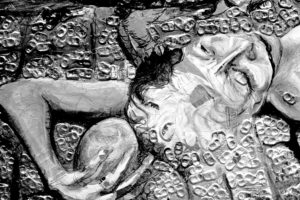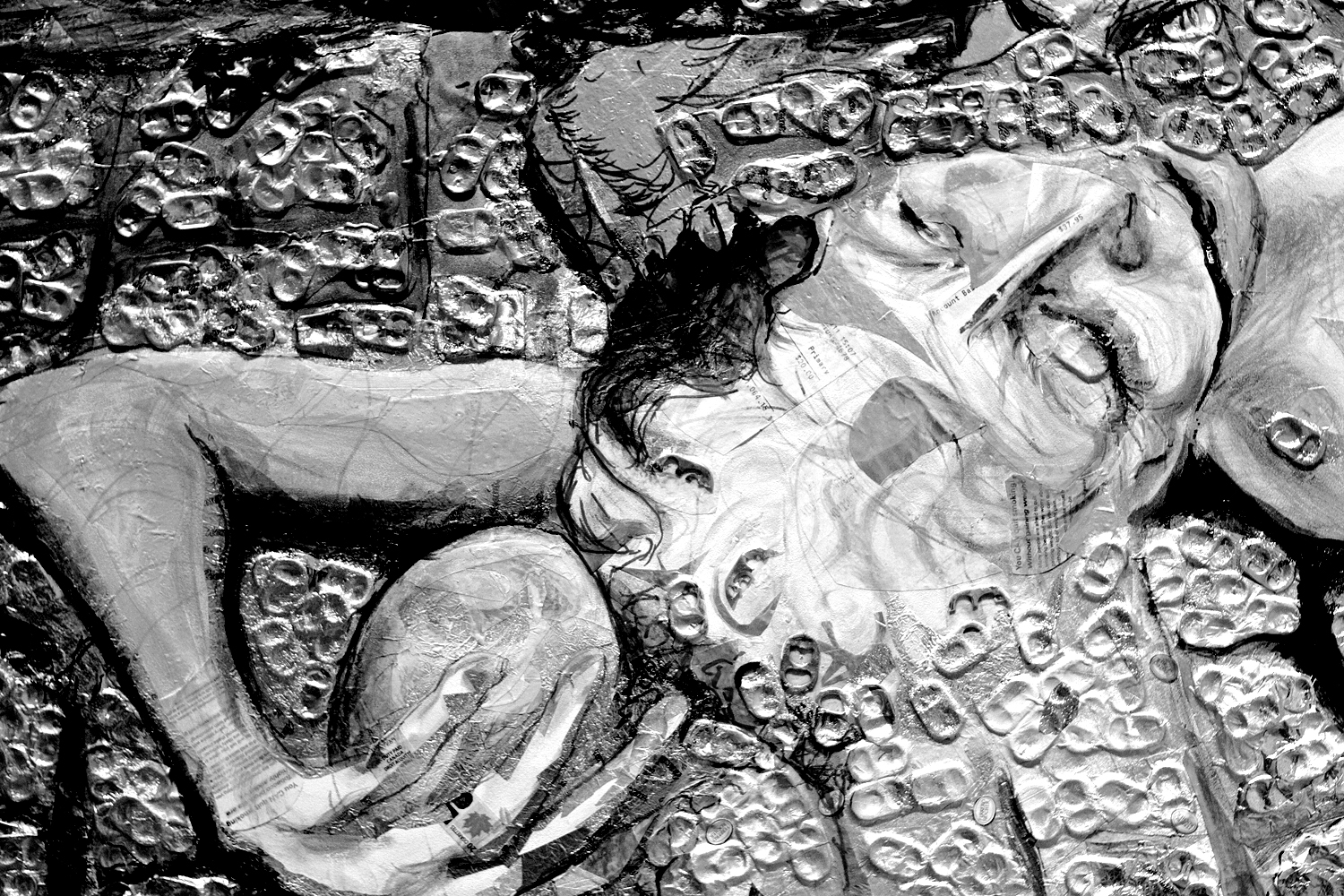Visual arts major Andrea Silk places mythological gods in a mosaic of luxurious trash to protest the average North American ecological footprint
Arts editor
@Peachcrate

For weeks, Andrea Silk has been collecting garbage.
The 24-year-old mixed media artist and visual arts student received donations of reflective trash for the making of her exhibition The Death of the Old Gods in the Gales Gallery, a collection rife with social commentary about the environment. Cigarette and chewing gum foil, chocolate wrappers, and pop can tabs glint around depictions of mythological Greek gods and goddesses in a mosaic of silver and gold.
“Gold and silver have been worth money for eons, but these are worthless,” says Silk, gesturing to a cluster of pop can tabs on her piece depicting Artemis. The shiny material makes the pieces decorative and eye-catching to attract the viewers, a trap she consciously designed. In North America, life is so privileged that even the garbage we throw away is charming and luxurious. But Silk is concerned, for instance, with the moment in time when the Earth’s aluminum deposits are exhausted.
More pressing for Silk is the reality that the average North American’s ecological footprint hardly has consequences for us.
“Who really gets hurt by foil?” she asks. “It’s not white people.”
She enforces ecological sobriety through Greek gods and goddesses. Standing for different aspects of our environment, the gods serve as checks for every way we affect nature.
For instance, she uses Hades, god of the underworld, to comment on the detriment of formaldehyde in preservation use; Artemis, the goddess of animals and wilderness, to criticize transnational highways for intercepting migration routes; and Poseidon, the god of the sea, to advocate fish rights. The artist’s depiction of an otherwise powerful figure shows Poseidon in the fetal position wrapped in the blue of the ocean, waiting to be scooped up by a fishing net.
“I think the gods helped people understand the environment they lived in,” says Silk. She uses the timeless influence of the gods to convince her audience of the importance and fragility of the environment, and she gets to mould the gods to her liking. In Euripides’ time, for instance, playwrights invoked gods and goddesses regularly.
“It was totally okay to just take Apollo and have him do whatever you wanted,” she says. “It wasn’t sacrilegious. They used them as puppets.” Playwrights were constantly concerned with bestowing moral guidance in their plays through the gods because people took them seriously.
“Say you were horny,” continues Silk. “You were literally possessed by Aphrodite.”
Silk preserves the power and majesty of the gods by depicting them in all their beauty. While the scenes they appear in are dream-like and at times squalid, the artist takes a representational approach, painting ideally beautiful human-like faces. “AphrodiTron” depicts the goddess of love with pale, white skin, rouged cheeks, and uncharacteristic tinges of blue.
This is Silk’s way of protesting another social ill called shadeism, the practise of grouping and segregating people of colour with a bias towards paler skin.
“When I deal with white people, I paint so much blue into them,” she admits.
Silk also admits that she’s fascinated with the way the garbage in her work discolours with air exposure. She traces a finger appreciatively at the red undertones the cigarette foil has come to bear under the gallery’s bright lights
Her favourite garbage, however, is the snake skin paper-machéd to the piece “The Double Queen and the Hermes Revival”. The material looks brittle and fragile on the canvas, but to the touch, it’s durable and coarse, giving the piece an interesting texture. Silk invites her audience to stroke the snake skin with their fingers. Her source of snake skin is her own two pet snakes, Cleo and Monte.
Cleo got her name because Cleopatra, originally of Greek descent, wore ball pythons around her wrists. In the future, when it comes to exploring social issues in her work, environmentalism may not be a constant, but the authority of Greek mythological gods will always pervade her art.
Andrea Silk’s exhibition will stay in the Gales Gallery until February 10.


